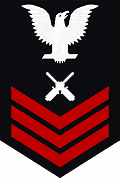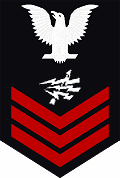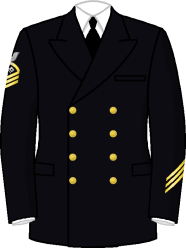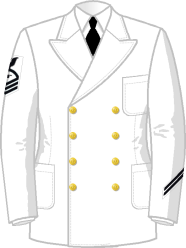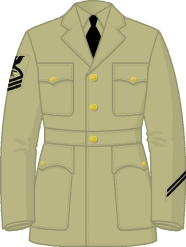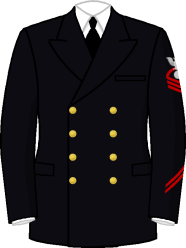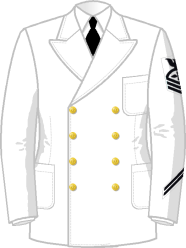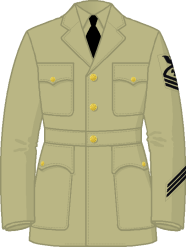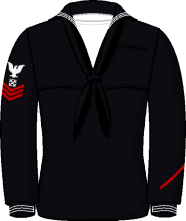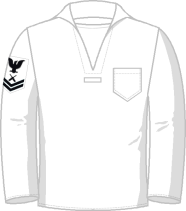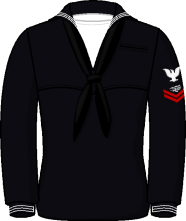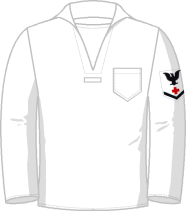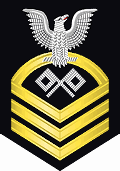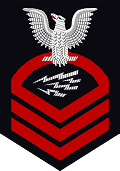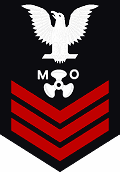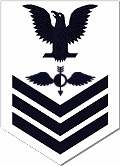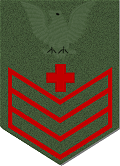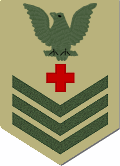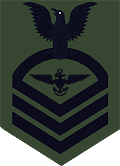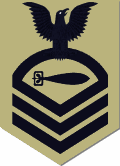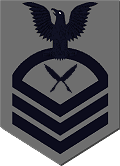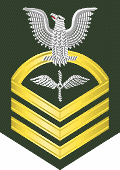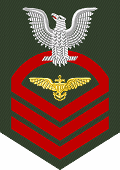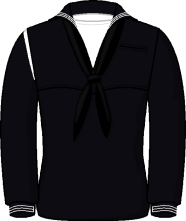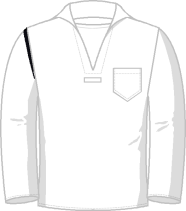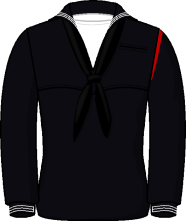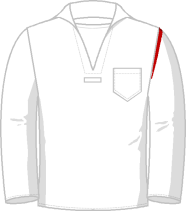US Navy Enlisted Rating Insignia of
World War II
The enlisted structure of the US Navy in World War II was similar to that of the present day, but there were a still number of differences specific to the various branches of personnel. A more detailed examination by branch can be found on the following pages:
Petty Officers
Petty officers were distinguished by a rating badge worn on the upper arm. It consisted of an eagle, a specialty mark, and chevrons indicating the grade of rank. Petty officers of the Seaman Branch wore the badge on the right sleeve, all other branches wore it on the left. In the Uniform Regulations of 1941 it was directed that the eagle's head always face forward, so on left-arm rating badges the eagle faces the viewer's left, and vice versa for right-arm rating badges.
The number of chevrons in the rating badge indicated the grade, with an arc on top for chief petty officers
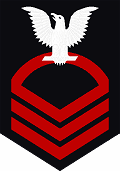
|
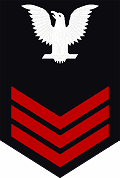
|
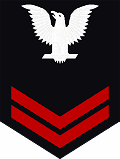
|
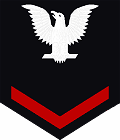
|
Chief Petty Officer |
Petty Officer 1st Class |
Petty Officer 2nd Class |
Petty Officer 3rd Class |
There were a number of different color schemes for rating badge, depending upon the uniform:
Non-Rated
Personnel below the rate of petty officer were termed "non-rated." In most enlisted branches, the non-rated personnel filled the lowest three pay grades, but the path of Engine Room Force and music personnel moved them into higher pay grades before becoming petty officers. In a revision to the enlisted structure effective January 1, 1944, the non-rated pay grades were standardized across all branches.
Most non-rated personnel were distinguished by a branch mark around the shoulder seam of the jumper. For seamen the mark was white on blue jumpers, blue on white jumpers and worn on the right side. For firemen of the Enginer Room Force, the mark was worn on the left and was red on blue and white jumpers. A few ratings did not have a branch mark, and instead wore distinguishing marks on the sleeve.
The grade of non-rated personnel was indicated by white cuff stripes on the dress blue jumper. These were not worn on the undress blue or white jumpers. During the war dress blue jumpers began to be issued to recruits without the single stripe for apprentice seaman and steward's mate third class.
Before January, 1944
|
Pay Grade 3
|
|
|
|
|
no branch mark
|
|
|
|
|
|
|

lower left sleeve
|
|
|
|
|
|
|

|
|
|
|
|
|
|
Musician 1st Class
|
|
|
|
|
Pay Grade 4
|
|
|

|
|
|
|
|
|
|
|
|
|
|
|
|
|

|
|
|
|
|
|
|
Fireman 1st Class
|
|
|
|
|
|
|
Pay Grade 5
|
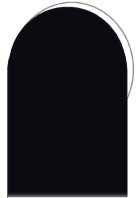
|

|
no branch mark
|
no branch mark
|
no branch mark
|
no branch mark
|
|
|
|

upper left sleeve
|

lower left sleeve
|

upper left sleeve
|

upper left sleeve
|

|

|

|

|

|

|
| Seaman 1st Class
|
Fireman 2nd Class
|
Hospital Apprentice 1st Class
|
Musician 2nd Class
|
Bugler 1st Class
|
Mess Attendant 1st Class
(Steward's Mate 1st Class after Feb. 1943)
|
|
|
Pay Grade 6
|

|

|
no branch mark
|
|
no branch mark
|
no branch mark
|
|
|
|

upper left sleeve
|
|

upper left sleeve
|

upper left sleeve
|

|

|

|
|

|

|
| Seaman 2nd Class
|
Fireman 3rd Class
|
Hospital Apprentice 2nd Class
|
|
Bugler 2nd Class
|
Mess Attendant 2nd Class
(Steward's Mate 2nd Class after Feb. 1943)
|
|
|
Pay Grade 7
|

|
|
|
|
|
no branch mark
|
|
|
|
|
|
|

upper left sleeve
|

|
|
|
|
|

|
| Apprentice Seaman
|
|
|
|
|
Mess Attendant 3rd Class
(Steward's Mate 3rd Class after Feb. 1943)
|
|
After January 1, 1944
|
Pay Grade 5
|

|

|
no branch mark
|
no branch mark
|
no branch mark
|
|
|
|

upper left sleeve
|

upper left sleeve
|

upper left sleeve
|

|

|

|

|

|
| Seaman 1st Class
|
Fireman 1st Class
|
Hospital Apprentice 1st Class
|
Bugler 1st Class
|
Steward's Mate 1st Class
|
|
|
Pay Grade 6
|

|

|
no branch mark
|
|
no branch mark
|
no branch mark
|
|
|
|

upper left sleeve
|
|

upper left sleeve
|

upper left sleeve
|

|

|

|
|

|

|
| Seaman 2nd Class
|
Fireman 2nd Class
|
Hospital Apprentice 2nd Class
|
|
Bugler 2nd Class
|
Steward's Mate 2nd Class
|
|
|
Pay Grade 7
|

|
|
|
|
|
no branch mark
|
|
|
|
|
|
|

upper left sleeve
|

|
|
|
|
|

|
| Apprentice Seaman
|
|
|
|
|
Steward's Mate 3rd Class
|
|
Enlisted women wore coat-style uniforms rather than jumpers, and thus could not display cuff stripes as men did. In Spetember 1944 new insignia were authorized for non-rated WAVEs, which consisted of diagonal stripes on the upper left sleeve. Distinguishing marks, as in the case of hospital apprentices, were worn directly above the stripes. The backgrounds were the same as for women's rating badges. This would be the basis of the "group rate" insignia for all personnel in 1948.

|

|

|

|
| Hospital Apprentice 1st Class |
Seaman 1st Class |
Hospital Apprentice 2nd Class |
Seaman 2nd Class |
Sources
The pages on US Navy World War II enlisted ratings and insignia are based primarily on the following:
- US Navy Department, Bureau of Naval Personnel Manual, 1942, revised through 1946, Washington DC, Government Printing Office, 1942-1946.
- US Navy Department, US Navy Uniform Regulations, 1941, revised through 1946, Washington DC, Government Printing Office, 1941-1946
- John Stacey, United States Navy Rating Badges and Marks 1833 to 2008, Matthews NC, ASMIC Pubs, 2008.
- US Navy Department, Bureau of Naval Personnel Information Bulletin and All Hands monthly, 1941-1946, online archive.
- US Department of the Navy, Naval History and Heritage Command, "Ratings (Jobs) of Enlisted Personnel in the U. S. Navy".
- US Department of the Navy, Naval History and Heritage Command, "Uniform Regulations, Women's Reserve, United States Naval Reserve, 1943".
All text and images © Justin T. Broderick, 2013 unless otherwise indicated.

